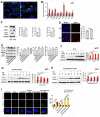MSC-derived exosomes protect auditory hair cells from neomycin-induced damage via autophagy regulation
- PMID: 38217055
- PMCID: PMC10787390
- DOI: 10.1186/s40659-023-00475-w
MSC-derived exosomes protect auditory hair cells from neomycin-induced damage via autophagy regulation
Abstract
Background: Sensorineural hearing loss (SNHL) poses a major threat to both physical and mental health; however, there is still a lack of effective drugs to treat the disease. Recently, novel biological therapies, such as mesenchymal stem cells (MSCs) and their products, namely, exosomes, are showing promising therapeutic potential due to their low immunogenicity, few ethical concerns, and easy accessibility. Nevertheless, the precise mechanisms underlying the therapeutic effects of MSC-derived exosomes remain unclear.
Results: Exosomes derived from MSCs reduced hearing and hair cell loss caused by neomycin-induced damage in models in vivo and in vitro. In addition, MSC-derived exosomes modulated autophagy in hair cells to exert a protective effect. Mechanistically, exogenously administered exosomes were internalized by hair cells and subsequently upregulated endocytic gene expression and endosome formation, ultimately leading to autophagy activation. This increased autophagic activity promoted cell survival, decreased the mitochondrial oxidative stress level and the apoptosis rate in hair cells, and ameliorated neomycin-induced ototoxicity.
Conclusions: In summary, our findings reveal the otoprotective capacity of exogenous exosome-mediated autophagy activation in hair cells in an endocytosis-dependent manner, suggesting possibilities for deafness treatment.
Keywords: Aminoglycoside; Autophagy; Endocytosis; Exosome; Hair cell; Mesenchymal stem cell; Neomycin.
© 2024. The Author(s).
Conflict of interest statement
The authors have no relevant financial or non-financial interests to disclose.
Figures







References
-
- Deafness and Hearing Loss. Available online at: WHO; https://www.who.int/news-room/fact-sheets/detail/deafness-and-hearing-loss
MeSH terms
Substances
Grants and funding
LinkOut - more resources
Full Text Sources

